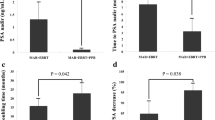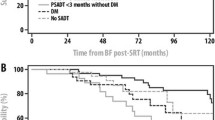Abstract
Background
To evaluate the relationship between biochemical recurrence and post-radiation prostate-specific antigen (PSA) kinetics in patients with localized prostate cancer treated by radiotherapy with various durations of androgen deprivation therapy (ADT).
Methods
We reviewed our single-institution, retrospectively maintained data of 144 patients with T1c-T3N0M0 prostate cancer who underwent three-dimensional conformal radiotherapy (3D-CRT) between December 2005 and December 2015 and 113 patients were fulfilled the inclusion criteria. In this cohort, 3D-CRT was delivered with a dose in the range from 70.0 to 72.0 Gy with ADT. All patients received ADT as concurrent regimens. Biochemical recurrence was defined on the basis of the following: “PSA nadir + 2.0 ng/ml or the clinical judgement of attending physicians”. Kaplan–Meier, log-rank, and Cox regression analyses were carried out.
Results
The median follow-up period was 54.0 months. The median duration of ADT was 17 months (interquartile range, 10–24 months). There was a trend toward statistical significant correlation between post-radiation PSA decline rate of ≥ 90% and PSA recurrence (p = 0.056). The same correlation could be observed in D’Amico high-risk patients (p = 0.036). However, it was not observed between PSA nadir and PSA recurrence (p = 0.40) in univariate analysis. Furthermore, multivariate analysis showed that post-radiation PSA decline rate of ≥ 90% was a significant predictor of biochemical recurrence in patients who received radiotherapy with various durations of ADT (p = 0.044).
Conclusions
Post-radiation PSA decline rate of ≥ 90% was a prognostic factor for biochemical recurrence in localized prostate cancer patients received 3D-CRT with various durations of ADT.



Similar content being viewed by others
References
Ferlay J, Steliarova-Foucher E, Lortet-Tieulent J et al (2013) Cancer incidence and mortality patterns in Europe: estimates for 40 countries in 2012. Eur J Cancer 49:1374–1403. https://doi.org/10.1016/j.ejca.2012.12.027
Matsuda T, Marugame T, Kamo KI et al (2010) Cancer incidence and incidence rates in Japan in 2004: based on data from 14 population-based cancer registries in the monitoring of cancer incidence in Japan (MCIJ) project. Jpn J Clin Oncol 40:1192–1200. https://doi.org/10.1093/jjco/hyq109
Hou Z, Li G, Bai S (2014) High dose versus conventional dose in external beam radiotherapy of prostate cancer: a meta-analysis of long-term follow-up. J Cancer Res Clin Oncol. https://doi.org/10.1007/s00432-014-1813-1
Zietman AL, Chung CS, Coen JJ et al (2004) 10-Year outcome for men with localized prostate cancer treated with external radiation therapy: results of a cohort study. J Urol 171:210–214. https://doi.org/10.1097/01.ju.0000100980.13364.a6
Bolla M, Gonzalez D, Warde P et al (1997) Improved survival in patients with locally advanced prostate cancer treated with radiotherapy and goserelin. N Engl J Med 337:295–300. https://doi.org/10.1056/NEJM199707313370502
Bolla M, Collette L, Blank L et al (2002) Long-term results with immediate androgen suppression and external irradiation in patients with locally advanced prostate cancer (an EORTC study): a phase III randomised trial. Lancet 360:103–106
Bolla M, de Reijke TM, Van Tienhoven G et al (2009) Duration of androgen suppression in the treatment of prostate cancer. N Engl J Med 360:2516–2527. https://doi.org/10.1056/NEJMoa0810095
Cooperberg MR, Pasta DJ, Elkin EP et al (2005) The University of California, San Francisco cancer of the prostate risk assessment score: a straightforward and reliable preoperative predictor of disease recurrence after radical prostatectomy. J Urol 173:1938–1942. https://doi.org/10.1097/01.ju.0000158155.33890.e7
D’Amico AV, Whittington R, Malkowicz SB et al (1998) Biochemical outcome after radical prostatectomy, external beam radiation therapy, or interstitial radiation therapy for clinically localized prostate cancer. JAMA 280:969–974
Stephenson AJ, Scardino PT, Kattan MW et al (2007) Predicting the outcome of salvage radiation therapy for recurrent prostate cancer after radical prostatectomy. J Clin Oncol 25:2035–2041. https://doi.org/10.1200/JCO.2006.08.9607
Crawford ED, Bennett CL, Andriole GL et al (2013) The utility of prostate-specific antigen in the management of advanced prostate cancer. BJU Int 112:548–560. https://doi.org/10.1111/bju.12061
Epstein JI, Allsbrook WCJ, Amin MB et al (2005) The 2005 International Society of Urological Pathology (ISUP) Consensus Conference on Gleason Grading of Prostatic Carcinoma. Am J Surg Pathol 29:1228–1242. https://doi.org/10.1097/01.pas.0000173646.99337.b1
D’Amico AV, Whittington R, Malkowicz SB et al (1998) Biochemical outcome after radical prostatectomy, external beam radiation therapy, or interstitial radiation therapy for clinically localized prostate cancer. JAMA 280:969–974. https://doi.org/10.1001/jama.280.11.969
Pisansky TM, Cha SS, Earle JD et al (1993) Prostate-specific antigen as a pretherapy prognostic factor in patients treated with radiation therapy for clinically localized prostate cancer. J Clin Oncol 11:2158–2166
Bolla M, Van Tienhoven G, Warde P et al (2010) External irradiation with or without long-term androgen suppression for prostate cancer with high metastatic risk: 10-year results of an EORTC randomised study. Lancet Oncol 11:1066–1073. https://doi.org/10.1016/S1470-2045(10)70223-0
Horwitz EM, Bae K, Hanks GE et al (2008) Ten-year follow-up of radiation therapy oncology group protocol 92-02: a phase III trial of the duration of elective androgen deprivation in locally advanced prostate cancer. J Clin Oncol 26:2497–2504. https://doi.org/10.1200/JCO.2007.14.9021
Denham JW, Steigler A, Lamb DS et al (2011) Short-term neoadjuvant androgen deprivation and radiotherapy for locally advanced prostate cancer: 10-year data from the TROG 96.01 randomised trial. Lancet Oncol 12:451–459. https://doi.org/10.1016/S1470-2045(11)70063-8
Roach M, Bae K, Speight J et al (2008) Short-term neoadjuvant androgen deprivation therapy and external-beam radiotherapy for locally advanced prostate cancer: long-term results of RTOG 8610. J Clin Oncol 26:585–591. https://doi.org/10.1200/JCO.2007.13.9881
Kupelian PA, Elshaikh M, Reddy CA et al (2002) Comparison of the efficacy of local therapies for localized prostate cancer in the prostate-specific antigen era: a large single-institution experience with radical prostatectomy and external-beam radiotherapy. J Clin Oncol 20:3376–3385. https://doi.org/10.1200/JCO.2002.01.150
Merino T, San Francisco IF, Rojas PA et al (2013) Intensity-modulated radiotherapy versus radical prostatectomy in patients with localized prostate cancer: long-term follow-up. BMC Cancer 13:530. https://doi.org/10.1186/1471-2407-13-530
D’Amico AV, Chen M-H, de Castro M et al (2012) Surrogate endpoints for prostate cancer-specific mortality after radiotherapy and androgen suppression therapy in men with localised or locally advanced prostate cancer: an analysis of two randomised trials. Lancet Oncol 13:189–195. https://doi.org/10.1016/S1470-2045(11)70295-9
Tseng YD, Chen M-H, Beard CJ et al (2012) Posttreatment prostate specific antigen nadir predicts prostate cancer specific and all cause mortality. J Urol 187:2068–2073. https://doi.org/10.1016/j.juro.2012.01.073
D’amico AV, Manola J, Loffredo M et al (2004) 6-Month Androgen Suppression Plus Radiation Therapy vs Radiation Therapy Alone for Patients With Clinically Localized Prostate Cancer. JAMA 292:821
Soto DE, Andridge RR, Pan CC et al (2008) In Patients Experiencing Biochemical Failure After Radiotherapy, Pretreatment Risk Group and PSA Velocity Predict Differences in Overall Survival and Biochemical Failure-Free Interval. Int J Radiat Oncol Biol Phys 71:1295–1301. https://doi.org/10.1016/j.ijrobp.2008.02.069
Author information
Authors and Affiliations
Corresponding author
Ethics declarations
Conflicts of interest
No author has any conflict of interest.
About this article
Cite this article
Fukuokaya, W., Kim, S., Natsuyama, T. et al. Significance of prostate-specific antigen kinetics after three-dimensional conformal radiotherapy with androgen deprivation therapy in patients with localized prostate cancer. Int J Clin Oncol 23, 361–367 (2018). https://doi.org/10.1007/s10147-017-1216-9
Received:
Accepted:
Published:
Issue Date:
DOI: https://doi.org/10.1007/s10147-017-1216-9




